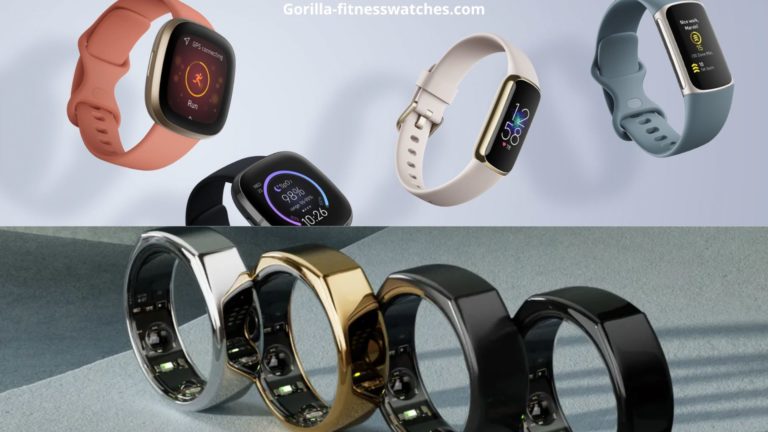The Oura Ring and the Fitbit are examples of smart wearables, although they serve different purposes and are worn in different ways.
Even though this smart ring and fitness tracker have very different design, but they have many features in common.
For your convenience, we’ll highlight these two wearables’ shared features and unique selling points and help you pick the best option.
So let’s get started!
Oura Ring Vs Fitbit
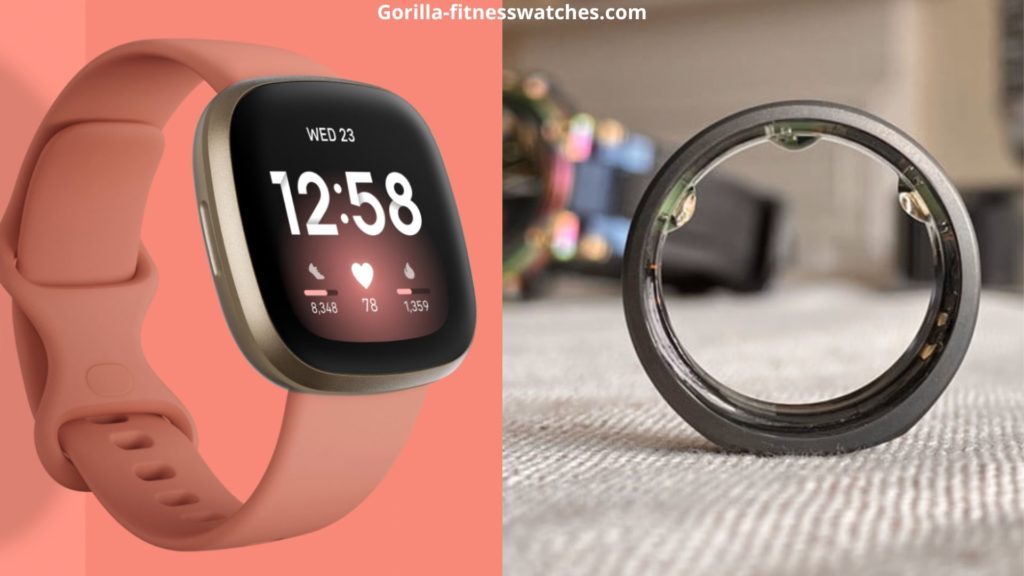
The Oura Ring and Fitbit placement on the user’s body is the primary point of differentiation between the two devices.
The Oura Ring is intended to be worn on the hand’s index finger that is used most frequently, whereas the Fitbit is a band worn around the wrist.
You might be wondering, if this is the only distinction, how exactly does it differentiate the two from one another? Regarding the tracking system, the location where you wear it has specific characteristics that set it apart from other places.
The Oura Ring is a fitness tracker worn on the finger and helps you keep track of your overall well-being.
Oura Ring is widely regarded as one of the most stylish and space-saving fitness trackers currently on the market.
This recognition comes from the realm of fitness monitoring. The smartphone’s lengthy battery life distinguishes it from other products in its market category.
It might look like a piece of jewellery at first glance, contributing to your overall attractiveness.
On the other hand, similar to the Oura Ring, Fitbit serves as an activity tracker. Indeed, you may monitor the current activity levels and compare them to the Oura Ring in real-time.
Perfect for wearing on the wrist, this band will constantly remind you to keep up with your fitness routine.
Fitbit is in a better position than its rivals to include activity tracking into a wider variety of its products thanks to its superior sensor-acceptance capacity. These sensors are too bulky to fit inside a ring comfortably.
Those serious about their cardiovascular and fat-burning workouts would benefit greatly from investing in a Fitbit tracker or watch.
The newest Fitbits have built-in GPS so you can monitor your outdoor activities wherever you go.
This allows it to automatically keep tabs on more complex operations, such as those involving elevation changes.
Oura Ring Vs Fitbit: Comparison Table
| Parameters of Comparison | Oura Ring | Fitbit |
| Material | Titanium | Aluminum and Stainless Steel |
| Battery life | Better Compared to Fitbit | Fitbit has less Battery Life compared to Oura Ring. |
| Activity Metrics | Activity Score, Steps, walking, Equivalency, Total Calorie Burn, Inactive Time, Dynamic Activity Goal, Goal Progress | Steps, Active Minutes, Calories, 24/7 heart rate, Resting heart rate |
| Sleep tracking | Yes | Yes |
| Measuring temperature while sleeping | Yes | No |
| Waterproof | Yes | Yes |
| Steps tracking | Yes | Yes |
| Wireless charging | Yes, it features a wireless charging system and uses USB to get charged | No, it does not feature any wireless charging system |
Related Post: Apple Watch VS Oura Ring
Oura Ring Vs Fitbit: Key Features
Key Features of Oura Ring
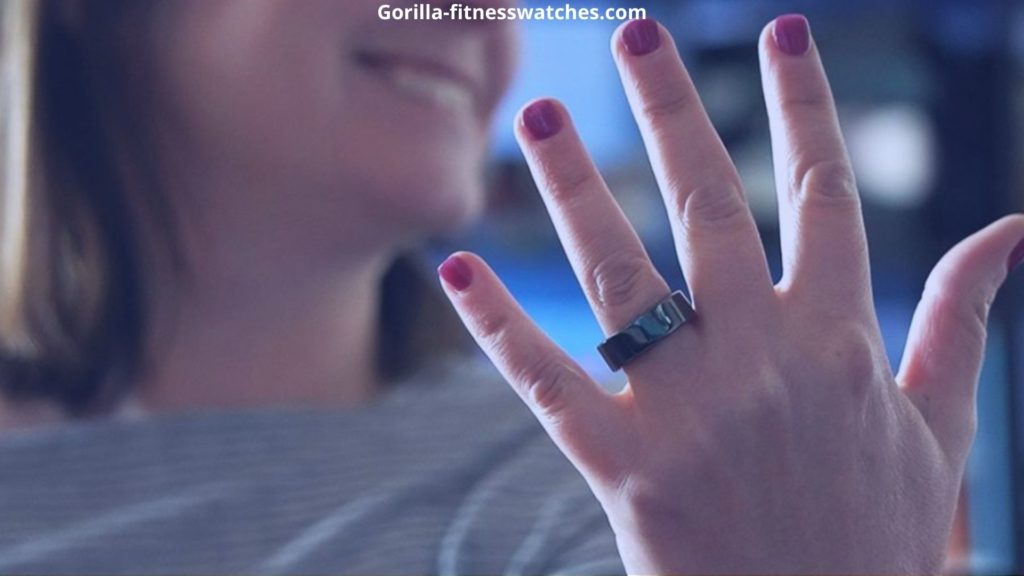
Oura rings are made by Oura Health Ltd., a firm established in 2013. Being a ring, it lacks a display. You’ll need a smartphone if you want to monitor the data collected by this ring.
Here some of the features of Oura Ring:
- Oura ring is a well-known activity and sleep monitor.
- This piece of jewelry is meant to be worn on the fingers.
- Movements, oxygen levels, and heart rate can all be accurately monitored using this device.
- Oura’s ring has a feedback system that causes it to vibrate whenever it detects a low oxygen level or an abnormal heart rate.
- Oura rings provide a “readiness” score indicating when it’s time to get back physically into the swing of things.
- It has a long battery life and is very simple to use.
Key Features of Fitbit
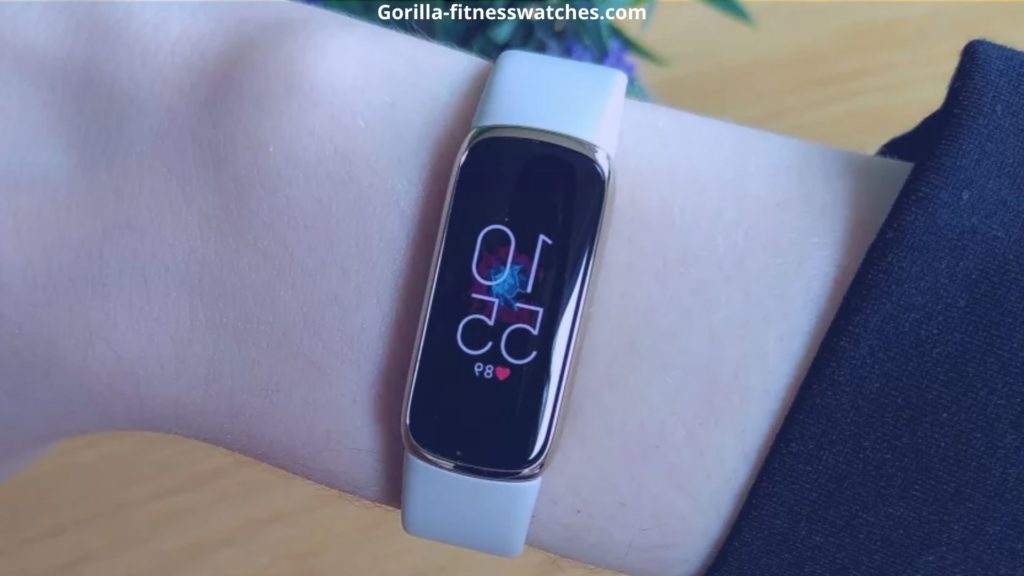
A Fitbit is designed to be worn on the wrist, while the Oura ring is supposed to be worn on the finger.
Fitbit can records physical motion, exercise, distance covered, and calories burned. It provides a more in-depth look at your heart rate while you sleep. It has a display for quickly viewing your data.
The following are some of the most critical aspects of the Fitbit:
- To monitor your heart rate, Fitbit is the best option.
- It is a wrist-worn smartwatch designed to monitor things like sleep duration and energy expenditure.
- It counts the number of steps you take and the flights of stairs you ascend.
- That workout session is recorded for later review.
- Because it’s a wristband, it has a display for monitoring data.
- A reminder function is available on Fitbit as well.
The above mentioned expressions define what makes Fitbit unique. If you’re looking to invest in a health tracking device, you should familiarize yourself with the key distinctions between the two options above.
The Oura ring and the Fitbit both have their advantages and disadvantages.
To make the best decision, you must pay attention to even the minute details. Therefore, let’s compare the fitness tracking features of Oura Ring to the Fitbit to determine which one is the better buy.
Oura Ring Vs Fitbit: Fitness Tracking
Here is a detailed review of the fitness tracking features of both devices
Oura Ring fitness tracking
Oura takes advantage of this design principle by accommodating a wide variety of practical sensors. Some of these can be found in Fitbit gadgets, while others can’t.
There are sensors known as accelerometers and gyroscopes that measure motion to keep track of your steps. Motion sensors are a given in wearables these days, including the gadgets that Fitbit makes.
In addition to that, two infrared light sensors can determine your heart rate and whether or not you are asleep. According to Oura, utilizing an infrared sensor to capture measures is more reliable for taking biometric readings on people with various skin tones since it better penetrates the skin.
Oura will also monitor your body temperature using two sensors built into the device and measure temperature by penetrating the skin of your finger.
When it comes to Fitbit, the temperature Sensor is only found in Fitbit Sense.
Oura can inform users if they are experiencing uncomfortable levels of heat or cold by measuring the skin’s temperature on the user’s finger and using that information.
If you are concerned that you will get sick or want to make sure that you are physically ready for the day ahead, having that knowledge on hand can be helpful.
Other relevant aspects that Oura can capture include:
- The total number of calories burned.
- The number of calories burned during activity.
- The amount of time spent sedentary.
- Walking equivalence.
Activity measurements provided by Oura:
- The score for the activity Steps
- Equivalency is reached by walking
- Activity level and overall calorie expenditure
- A period of inactivity
- The objective of dynamic activity
- Goal progress
Fitbit fitness tracking
Fitbit can provide a comprehensive range of fitness tracking features across its product line.
All of the company’s trackers and watches use motion sensors analogous to those found in the Oura Ring to monitor sleep and count steps.
Fitbit’s that have heart rate monitors allow users to continuously monitor their heart rates, record their heart rates at rest, and exercise according to predetermined heart rate zones.
In addition, the Fitbit trackers come with the most “Active Zone Minutes” feature, which is very famous among fitness enthusiasts. This will measure the time you spend in any heart-pumping activity.
The Fitbit app provides access to the tracking of female health for all of Fitbit’s trackers, and the company’s smartwatches bring some of the app’s capabilities directly to the wrist.
One Major sensor that Fitbit possesses but Oura does not is the SpO2 sensor. It helps you measure the blood oxygen level during workouts and at night and is considered the major wellness tracking feature.
Activity measurements provided by Fitbit include:
- Steps
- Active Minutes and Calories
- 24/7 heart rate
- The heart rate at rest
- SpO2 Max (on selected devices)
- ECG (Only Fitbit Sense)
- EDA sensor
Oura Ring Vs Fitbit: Sleep Tracking
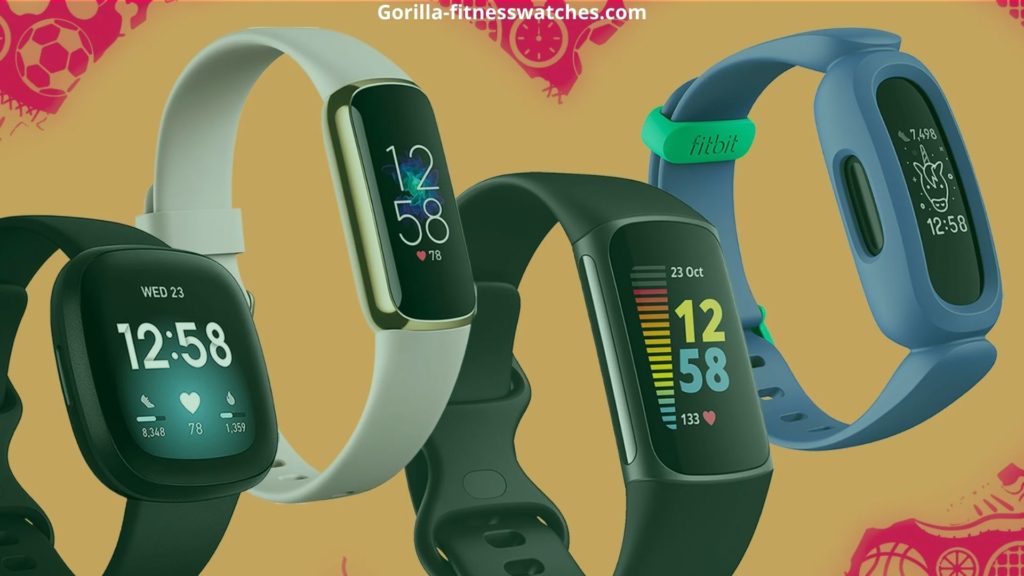
Oura was built from the ground up to monitor sleep. It provides a breakdown of sleep stages, such as light, REM, and deep sleep, in addition to metrics such as total sleep duration, time spent in bed, and the number of times your heart beats per minute.
One of Oura’s newest features is the ability to detect naps. It will automatically keep track of your naps and alter your preparedness level based on those recordings.
Fitbit also monitors sleep stages and uses metrics that are almost identical to those used by Oura.
The adaptability of Fitbit is one of its greatest strengths; it enables users to programme bedtime alerts and silent alarms, and these can be timed to go off at precisely the right moment during each stage of sleep, allowing them to get the most out of their rest and ensure that they begin each day on the right foot.
The Oura and the Fitbit give you an all-encompassing view of your sleep and give it a score out of 100 depending on how well your sleep goes based on several different sleep metrics.
In addition to other contributors like relaxation, which are calculated based on several factors in addition to the quality of your sleep.
Despite this, I find the sleep monitoring capabilities of the Oura to be superior to those of any Fitbit model, mainly because it provides more detailed information and more extensive insights.
The former option provides a level of precision that, due to the nature of the form factor of a smartwatch, the latter option cannot provide.
In terms of comfort, this comes down to individual preference, but, based on my experience, Oura is undoubtedly the superior option.
Oura Ring Vs Fitbit: Heart Rate Tracking
Oura’s heart rate monitoring technology is vastly upgraded, with new scales including daily heart rate (for continuous heart rate monitoring), workout heart rate (for recording heart rate during workouts and gaining insights afterwards), and restful time (for measuring how relaxed your mind and body).
All Oura rings report your RHR, HRV, minimum heart rate, and mean HRV.
Most Fitbits have a heart rate sensor that may be used to measure a person’s resting heart rate, maximum heart rate, and target heart rate during physical activity.
The active zone minutes feature of more recent Fitbits keeps track of the amount of time you spend engaged in vigorous physical activity.
Additionally, it employs zone notifications, wherein you are notified when you enter and leave a predetermined heart rate zone while exercising.
Oura Ring Vs Fitbit: Recovery Tracking
On a scale from 1 to 100, Oura assigns you a readiness score reflecting how well you have rested and are prepared to take on the day’s activities.
It considers several factors such as physical exertion, sleep quality, heart rate variability, core temperature, and the lowest resting heart rate ever recorded.
Oura doesn’t just look at the data from the previous day to determine your mental and physical health; it also considers weighted averages from the previous 14 days and compares those results to your long-term average from the preceding 60 days.
You may expect your Fitbit readiness score based on your past day’s worth of exercise, sleep, and heart rate variability.
A higher score indicates a more successful outcome—a low readiness score results from factors such as stress, lack of sleep, and strenuous exercise.
Tracking your recuperation with Fitbit and Oura is similar because they both utilize the same parameters to determine when you’re ready to return to your normal activities.
They are equally true, by the way. The catch is that you must be a $9.99 monthly premium customer to see your Fitbit readiness score.
Oura is not only cost-free but also superior to Fitbit as a recovery monitoring tool because of its all-encompassing nature.
It’s also worth noting that the ring’s data collection method is more precise than that of a wrist band. In my opinion, Oura comes out on top.
Oura Ring Vs Fitbit: Accuracy
There is much debate about whether or not these fitness trackers provide reliable results. The Oura claims that its heart rate data is correct 99.9 per cent of the time, and its HRV data is accurate 98.4 per cent of the time. To put it another way, this is like an ECG.
The heart rate data provided by Fitbit appears to be reliable as well. But when it comes to actual numbers, like calories burnt and step taken, we get contradictory information.
After wearing a Fitbit Inspire and Oura ring for two days, I found that the two data sets didn’t agree with one another.
In terms of total calories burned, the Oura Ring was more accurate than the Fitbit on both days, while the Fitbit was more accurate in terms of my step count.
Oura Ring Vs Fitbit: Design and Comfort
The Oura Ring is the best option in terms of its design and level of comfort. Even though not everyone is accustomed to wearing rings, Oura has altered its product to be less cumbersome and more lightweight.
Fitbits, on the other hand, are intended to be worn around the wrist. They have the potential to be more obnoxious, they have the potential to catch on your clothing, and they are not exactly the most elegant accessory.
Regarding monitoring how well you sleep, the Oura Ring performs noticeably better than the Fitbit.
It’s possible that ,you’ll have to get used to it at first, but after a few days, the ring won’t even be noticeable to you when you’re sleeping.
The Fitbit, however, is significantly more cumbersome and distracting to wear when you are sleeping.
Oura Ring Vs Fitbit: Price
The Fitbit watches come with different price tags, depending on the models and the number of features the watch offers. Here is a price table of all Fitbit trackers and watches.
| Fitbit Sense | $299 |
| Fitbit Versa 3 | $189 |
| Fitbit Versa 2 | $119 |
| Fitbit Charge 5 | $129 |
| Fitbit Charge 4 | $130 |
| Fitbit Luxe | $129 |
On the other Oura ring is pretty expensive than Fitbit’s devices. It cost you about $299, similar to Fitbit’s flagship cost.
FAQs
Is The Oura Ring Worth The Money?
In no uncertain terms, the Oura ring is a desirable accessory. Amazingly, you can do a lot of good for your health with the help of this clever tool. Being a ring, it can stay on your finger all day without bothering you.
The Oura ring features a cutting-edge design. The battery life is likewise impressive. A true and accurate reading of heart rate (HR) has been reported by it. The Oura ring is a fantastic investment for money for many reasons.
Can We Say That The Oura Ring Outshines The Apple Watch?
Oura rings are superior to Apple watches if you want to receive comprehensive data on your sleep patterns and readiness levels each morning.
Where Should I Wear My Oura Ring?
Any finger on each hand is appropriate for Oura ring. Pick the finger that works best for you. This device should rest on whichever finger is most convenient for you.
My two favorite fingers are the middle one and the ring finger on the right hand. Oura ring can be worn on the ring finger if that makes you feel more at ease.
Conclusion
There is no way that these two wrist devices are similar. The Oura Ring is the best choice if you value discretion and privacy while needing a tracking device. Fitbit is for you if you’re the type who needs to keep tabs on your progress all the time.
It’s encouraging that the software and tracking features are so similar. If we’re going to evaluate these two tools based on their qualities, it isn’t easy to provide a clear response. Identifying the right plan for you requires thinking about your specific health and fitness objectives.
If you want a wearable that monitors your rest, activity, and recovery around the clock, Oura is your best bet. Oura can be used at any time of the day or night, and its data and insights are always reliable. However, if you’re searching for a wearable that tracks your daytime activities and fitness, Fitbit devices are your best bet.

